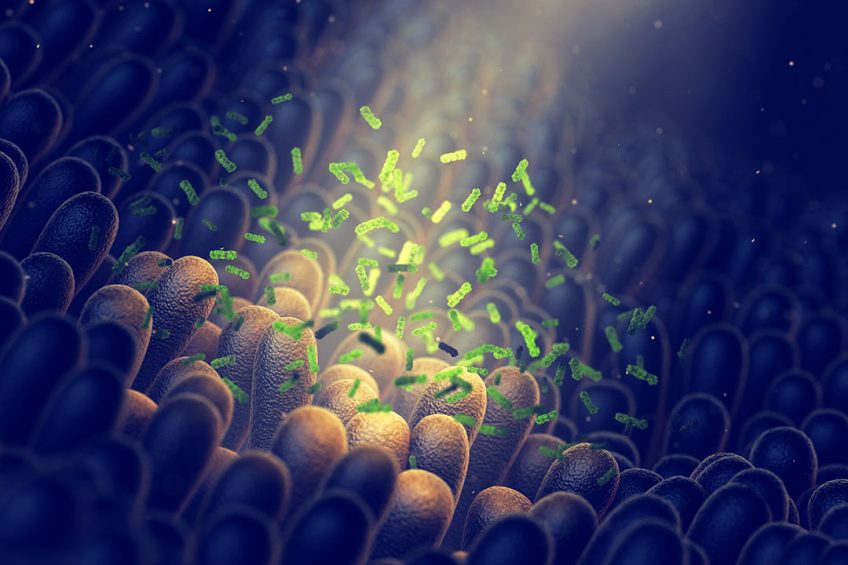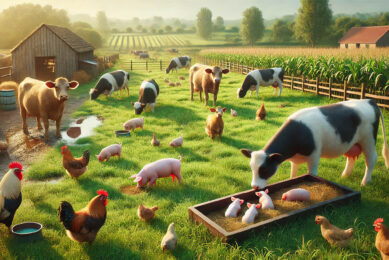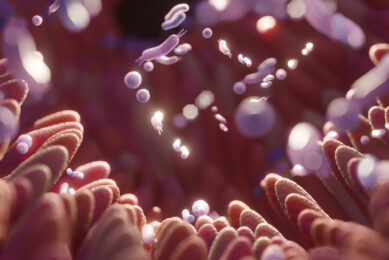‘No antibiotics’ means increased need for emulsification

A disbalanced microflora has an important negative effect on digestibility. To counteract this, the activity of a nutritional emulsifier should be considered. This additive does not only save costs but also supports flocks with intestinal health issues.
 Rearing animals in antibiotic-free systems is a challenge. The big question is how to deal with increased pathogenic pressure and optimise gut health. When disbalanced, the microflora can have a big impact on the digestibility of nutrients. Fat digestibility, in particular, will be affected to a large extend by bacteria that impair the function of bile acids, vital components of the fat digestibility apparatus. These bacteria are more pronounced in disbalanced gastrointestinal tracts and form a threat, especially when the usage of antibiotics is limited. Low fat digestibility will imply a loss of energy which will not be available for growth. To counteract this suboptimal situation a nutritional emulsifier can be added to the diet. This additive does not only save costs in healthy animals but also supports flocks with intestinal health issues.
Rearing animals in antibiotic-free systems is a challenge. The big question is how to deal with increased pathogenic pressure and optimise gut health. When disbalanced, the microflora can have a big impact on the digestibility of nutrients. Fat digestibility, in particular, will be affected to a large extend by bacteria that impair the function of bile acids, vital components of the fat digestibility apparatus. These bacteria are more pronounced in disbalanced gastrointestinal tracts and form a threat, especially when the usage of antibiotics is limited. Low fat digestibility will imply a loss of energy which will not be available for growth. To counteract this suboptimal situation a nutritional emulsifier can be added to the diet. This additive does not only save costs in healthy animals but also supports flocks with intestinal health issues.Bile acids as natural emulsifiers
Fat digestion is to a large extend dependent on bile acids, next to pancreatic lipase and colipase. Bile acids, synthesised in liver cells, will act at the lipid/water interface and help in the formation of micelles, sphere-like aggregates of fat in water. Bile acid-containing micelles augment the activity of lipase towards the digestion of lipids. Prior to secretion in the intestine, conjugation with taurine or glycine takes place in liver cells to form conjugated bile acids (Figure 1). Only conjugated bile acids are able to act efficiently as an emulsifier. The unconjugated forms are insoluble in water due to their specific molecular structure and subsequent acid-base properties. They will be excreted in faeces. Both commensal, symbiotic and pathogenic intestinal bacteria are capable of hydrolysing the amide bond and remove glycine and taurine. Clostridium perfringens, for example, was shown to express high levels of the bile salt hydrolase enzyme. When hydrolysed, the bile salt is in its unconjugated form and loses its ability to act as a natural emulsifier, resulting in a decreased fat digestion.
Figure 1 – Conjugation with taurine or glycine to form a conjugated, active bile salt.

Imbalanced microflora and its effect on fat digestibility
The influence of microbiota, antibiotics and conjugated bile acid concentration on the adsorption of fat was investigated in broilers (Table 1). The group without antibiotics showed high numbers of C. perfringens in the small intestine and lower amounts of conjugated bile acids. Lower amounts of conjugated bile acids reduced the absorption of fatty acids and fat soluble compounds (e.g. α-tocopherol). Lipase activity was also assessed and shown to be decreased in antibiotic free birds, suggesting an effect of the conjugated bile salts on the activity of lipase.
The same trend was observed in another trial (Table 2). In this study the effect of the microbiota on the conjugated bile acid status and subsequent fat digestion was compared between birds reared in sterilised conditions and conventional reared birds. Birds reared in sterilised conditions showed a higher lipid faecal apparent digestibility compared to conventionally reared birds, confirming the negative effect of some bacteria on fat digestion. This can be explained by the difference in the concentration of conjugated bile salts.
The need for a nutritional emulsifier
Fat digestion is influenced by many factors (e.g. fat source, age). Less attention is given to the effect of the microflora. Considering the literature work stated above it should be an important factor to take into account. Orffa engineered a nutritional emulsifier to reach maximal potential in the intestinal environment and improve digestion. The most important parameter to choose the optimal emulsifier for every specific application is HLB (hydrophilic-lipophilic balance). An emulsifier with a low HLB is more fat soluble (lipophilic) and an emulsifier with a high HLB is more water soluble (hydrophilic). Due to the fact that an animal consumes almost twice as much water as feed, the intestine is a very watery environment. The goal of a nutritional emulsifier is to optimise the emulsification and micelle formation in the intestine and therefore an emulsifier with a high HLB (hydrophilic) is most efficient.
In recent years, several faecal metabolic studies with broilers have been performed by Orffa to examine the effects of the nutritional emulsifier, Excential Energy Plus. The results show that the nutritional emulsifier is able to increase energy (+76 kcal AMEn/kg), crude fat (+2.81%), dry matter (+1.41%) and crude protein (+1.68%) digestibility on average to a high extend versus the control treatment. The increase in digestibility seems to depend on the crude fat percentage in the diet.
Conclusion
A disbalance in gut microflora has an important negative effect on digestibility. To counteract this the activity of a nutritional emulsifier should be considered. Orffa’s nutritional emulsifier has the proven ability to increase nutrient digestion, which is important in a healthy broiler, but crucial in a pathogen challenged bird.
References are available on request
Author:
Brecht Bruneel, Central Technical Manager, Orffa, The Netherlands






